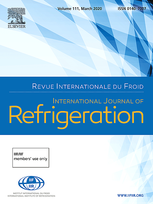
Recommended by the IIR / IIR document
A novel hydrogen liquefaction process based on LNG cold energy and mixed refrigerant cycle.
Author(s) : FARAMARZI S., MOUSAVI NAEYNIAN S. M., MAFI M., GHASEMIASL R.
Type of article: IJR article
Summary
A novel hydrogen liquefaction cycle with a capacity of 369 tons per day has been proposed. Given the fact that the process integration and appropriate design can reduce the power consumption of the light gas liquefaction cycle, wasted cold energy of a natural gas regasification system is integrated into the pre-cooling part of the liquid hydrogen production. In this study, after being evaporated in the pre-cooling part of the hydrogen liquefaction cycle, the liquefied natural gas (LNG) enters the steam methane reforming (SMR) to feed the hydrogen liquefaction process by hydrogen gas. Energy, exergy, and economic analyses are carried out to investigate the process. The mixed refrigerant method is implemented in the proposed model. The specific energy consumption (SEC) of the proposed process is 19.90% less than that of the similar cycles mentioned in the literature. The economic analysis results illustrate that the total annual cost of the proposed model is 13.43% less than that of the base model. A comparison between the proposed and other hydrogen liquefaction cycles is made to verify feasibility and efficiency. The minimum selling price of the liquid hydrogen is $ 2.07 in a payback time of three years, making it economically viable.
Available documents
Format PDF
Pages: 263-274
Available
Public price
20 €
Member price*
Free
* Best rate depending on membership category (see the detailed benefits of individual and corporate memberships).
Details
- Original title: A novel hydrogen liquefaction process based on LNG cold energy and mixed refrigerant cycle.
- Record ID : 30029134
- Languages: English
- Subject: Technology
- Source: International Journal of Refrigeration - Revue Internationale du Froid - vol. 131
- Publication date: 2021/11
- DOI: http://dx.doi.org/10.1016/j.ijrefrig.2021.07.022
- Document available for consultation in the library of the IIR headquarters only.
Links
See other articles in this issue (95)
See the source
Indexing
-
Themes:
Gas liquefaction and separation;
LNG and LPG - Keywords: Hydrogen; Liquefaction; LNG; Energy; Thermodynamic cycle; Energy consumption; Comparison; Cost; Modelling; Simulation; Recovery
-
Optimization and control strategy of BOG re-liq...
- Author(s) : GUO T., LIU L., SHEN J., JIANG Q., WU S., ZHOU Y., LIU Y.
- Date : 2023/09
- Languages : English
- Source: International Journal of Refrigeration - Revue Internationale du Froid - vol. 153
- Formats : PDF
View record
-
Comparison and analysis of two processes for BO...
- Author(s) : YIN L., JU Y.
- Date : 2020/07
- Languages : English
- Source: International Journal of Refrigeration - Revue Internationale du Froid - vol. 115
- Formats : PDF
View record
-
Consider dual independent expander refrigeratio...
- Author(s) : FOGLIETTA J. H.
- Date : 2004/01
- Languages : English
- Source: Hydrocarbon Processing - vol. 83 - n. 1
View record
-
Current and future role of natural gas supply c...
- Author(s) : YUSUF N., AL-ANSARI T.
- Date : 2023/11
- Languages : English
- Source: Energies - vol. 16 - n. 22
- Formats : PDF
View record
-
Design and analysis of CO2 cryogenic...
- Author(s) : BI Y., JU Y.
- Date : 2021/10
- Languages : English
- Source: International Journal of Refrigeration - Revue Internationale du Froid - vol. 130
- Formats : PDF
View record
